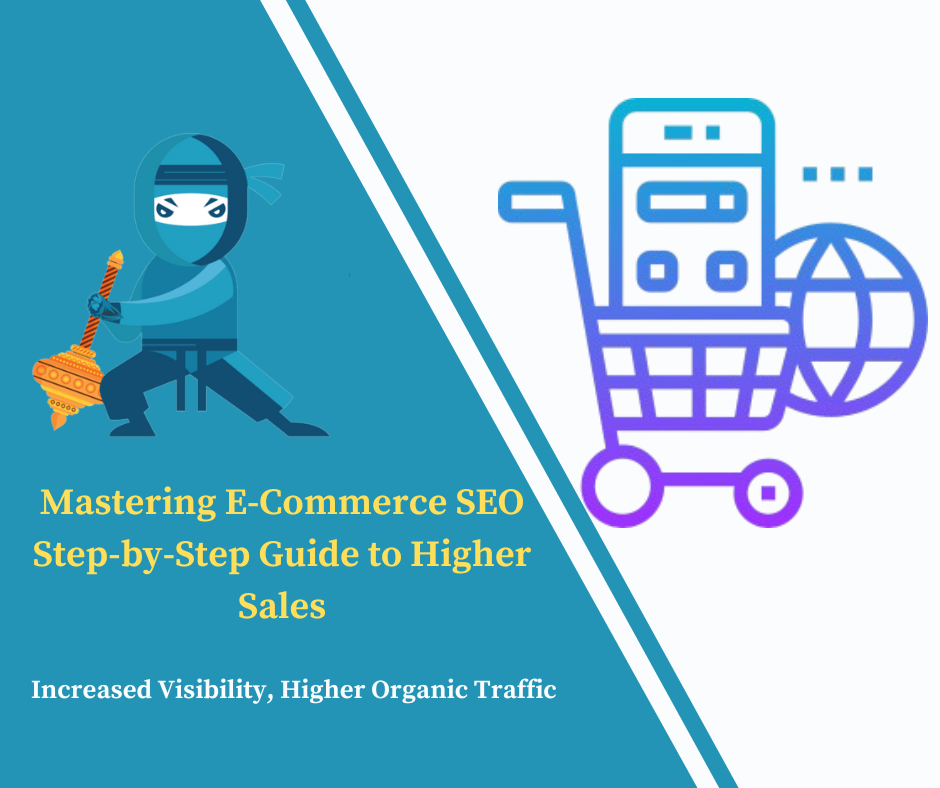Mastering E-Commerce SEO: Step-by-Step Guide to Higher Sales
In the rapidly evolving world of online retail, mastering E-Commerce SEO (Search Engine Optimization) is crucial for standing out in a crowded marketplace. As consumers increasingly turn to search engines to find products and make purchasing decisions, optimizing your e-commerce site to rank higher in search results becomes a strategic imperative. Effective E-Commerce SEO not only drives more organic traffic to your store but also enhances user experience, leading to higher sales and improved customer satisfaction.
Understanding E-Commerce SEO
E-commerce SEO involves optimizing your online store to rank higher in search engine results pages (SERPs). By targeting relevant keywords, enhancing your website’s structure, and improving user experience, you can attract more potential customers and increase conversions.
1. Conduct Thorough Keyword Research
The foundation of effective E-Commerce SEO is keyword research. Start by identifying the search terms and phrases that potential customers use to find products similar to yours. Use tools like Google Keyword Planner, Ahrefs, or SEMrush to discover high-volume, low-competition keywords.
Tips for Keyword Research:
Long-Tail Keywords: Focus on long-tail keywords that are more specific and less competitive. For example, instead of “shoes,” target “women’s waterproof hiking boots.”
Competitor Analysis: Analyze your competitors to find keywords they are ranking for and identify opportunities for your store.
2. Optimize Product Pages
Product pages are crucial for E-Commerce SEO. These pages need to be optimized for both search engines and users. Here’s how to do it:
Title Tags and Meta Descriptions:
Title Tags: Include primary keywords in your title tags. For example, “Best Organic Green Tea – Buy Online | YourStoreName.”
Meta Descriptions: Craft compelling meta descriptions that include your target keywords and entice users to click.
Product Descriptions:
Write unique, detailed product descriptions that incorporate relevant keywords naturally.
Avoid duplicate content by creating original descriptions for each product.
Images:
Optimize images by using descriptive file names and alt text that includes relevant keywords.
Compress images to improve page load speed.
3. Improve Website Structure and Navigation
A well-organized website structure enhances user experience and aids search engines in crawling your site efficiently.
Key Areas to Focus On:
Sitemap: Create an XML sitemap and submit it to Google Search Console to help search engines discover and index your pages.
Internal Linking: Use internal links to connect related products and categories. This helps spread link equity throughout your site and improves navigation.
URL Structure: Use clean, descriptive URLs that include target keywords. For instance, “https://hanuitsolutions.com/ecommerce/.”
4. Enhance User Experience (UX)
User experience plays a significant role in SEO. A site that is easy to navigate and provides a smooth shopping experience will not only rank better but also retain more customers.
Focus Areas for UX:
Mobile Optimization: Ensure your site is mobile-friendly as a large percentage of e-commerce traffic comes from mobile devices.
Page Load Speed: Optimize page load times by compressing files, leveraging browser caching, and using a content delivery network (CDN).
Easy Checkout Process: Simplify the checkout process to reduce cart abandonment rates. Offer multiple payment options and ensure a secure checkout.
5. Build High-Quality Backlinks
Backlinks are links from other websites to your own. They are a critical component of SEO as they signal to search engines that your site is credible and authoritative.
Strategies for Building Backlinks:
Guest Blogging: Write guest posts for reputable blogs in your industry with a link back to your site.
Product Reviews: Reach out to influencers or bloggers to review your products and include a link to your site.
Partnerships: Collaborate with complementary businesses for mutual backlink opportunities.
Also read: Speed Optimization: Reduce Page Load Time for Better SEO
6. Leverage Content Marketing
Content marketing can drive organic traffic and enhance your E-Commerce SEO efforts. Create valuable content that resonates with your audience and supports your SEO strategy.
Content Ideas:
Blog Posts: Write blog posts about topics related to your products, such as “How to Choose the Best Running Shoes” or “Top Trends in Home Decor.”
Product Guides: Create comprehensive buying guides and how-to articles to help customers make informed decisions.
Videos: Produce videos showcasing your products or demonstrating their uses.
7. Monitor and Analyze Performance
Regularly monitoring your SEO performance is essential to understanding what’s working and what needs improvement.
Tools for Analysis:
Google Analytics: Track metrics such as organic traffic, bounce rate, and conversion rate.
Google Search Console: Monitor your site’s performance in search results and identify issues that need addressing.
SEO Tools: Use tools like Ahrefs or SEMrush to analyze your site’s SEO health and track keyword rankings.
Also read: How to Optimize Product Pages to Drive More Sales
FAQ
What is E-Commerce SEO?
E-commerce SEO is the practice of optimizing an online store to improve its visibility in search engine results, attract more organic traffic, and ultimately increase sales.
Why is keyword research important for E-Commerce SEO?
Keyword research helps identify the search terms potential customers use to find products. By targeting these keywords, you can attract relevant traffic and increase the chances of conversion.
How can I optimize my product pages for SEO?
Optimize product pages by including relevant keywords in title tags, meta descriptions, and product descriptions. Also, use descriptive file names and alt text for images, and ensure your pages load quickly.
What role does user experience play in E-Commerce SEO?
User experience is crucial for SEO as it affects how visitors interact with your site. A positive user experience, including fast page load times and an easy checkout process, can improve your site’s rankings and conversion rates.
How can I build backlinks to my e-commerce site?
Build backlinks by guest blogging, reaching out to influencers for product reviews, and forming partnerships with complementary businesses.
What are some effective content marketing strategies for e-commerce?
Effective content marketing strategies include writing blog posts related to your products, creating comprehensive buying guides, and producing engaging videos.
How do I monitor my SEO performance?
Monitor your SEO performance using tools like Google Analytics, Google Search Console, and SEO analysis tools such as Ahrefs or SEMrush. Track metrics like organic traffic, keyword rankings, and conversion rates to assess and adjust your strategy.
Conclusion
Mastering E-Commerce SEO involves a comprehensive approach that includes keyword research, on-page optimization, user experience improvements, and ongoing performance analysis. By implementing these strategies, you can enhance your online store’s visibility, attract more targeted traffic, and ultimately drive higher sales. Stay committed to continuous improvement, and your e-commerce business will reap the benefits of effective SEO.








